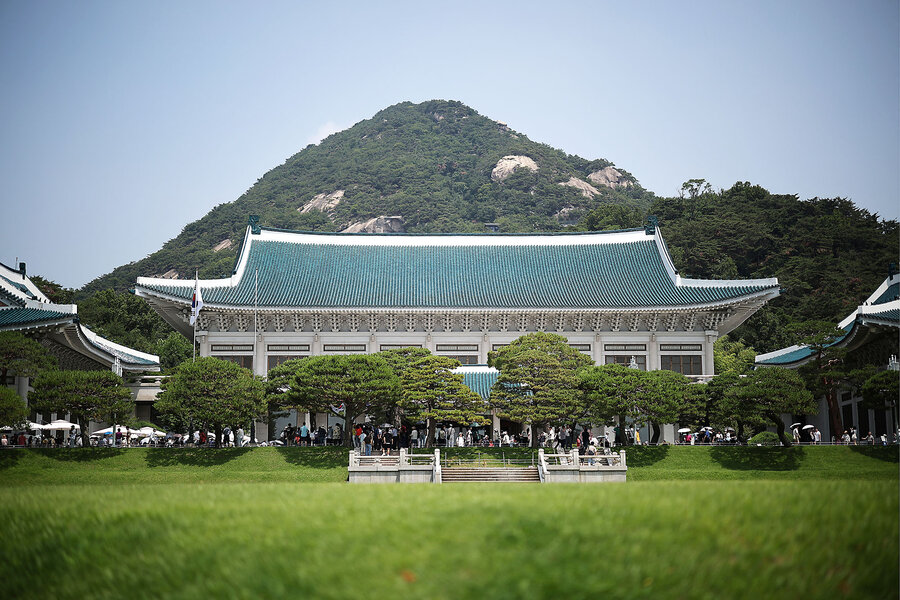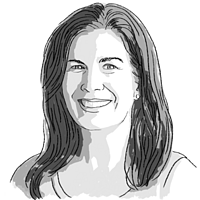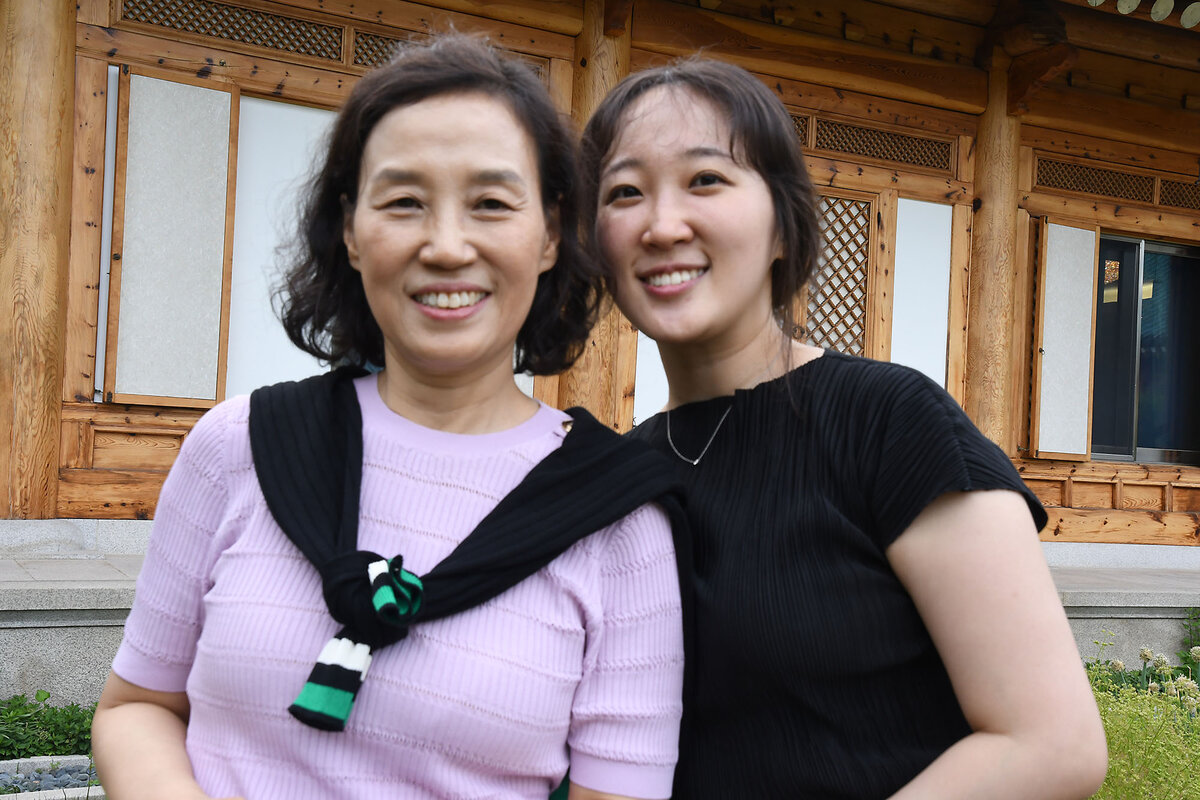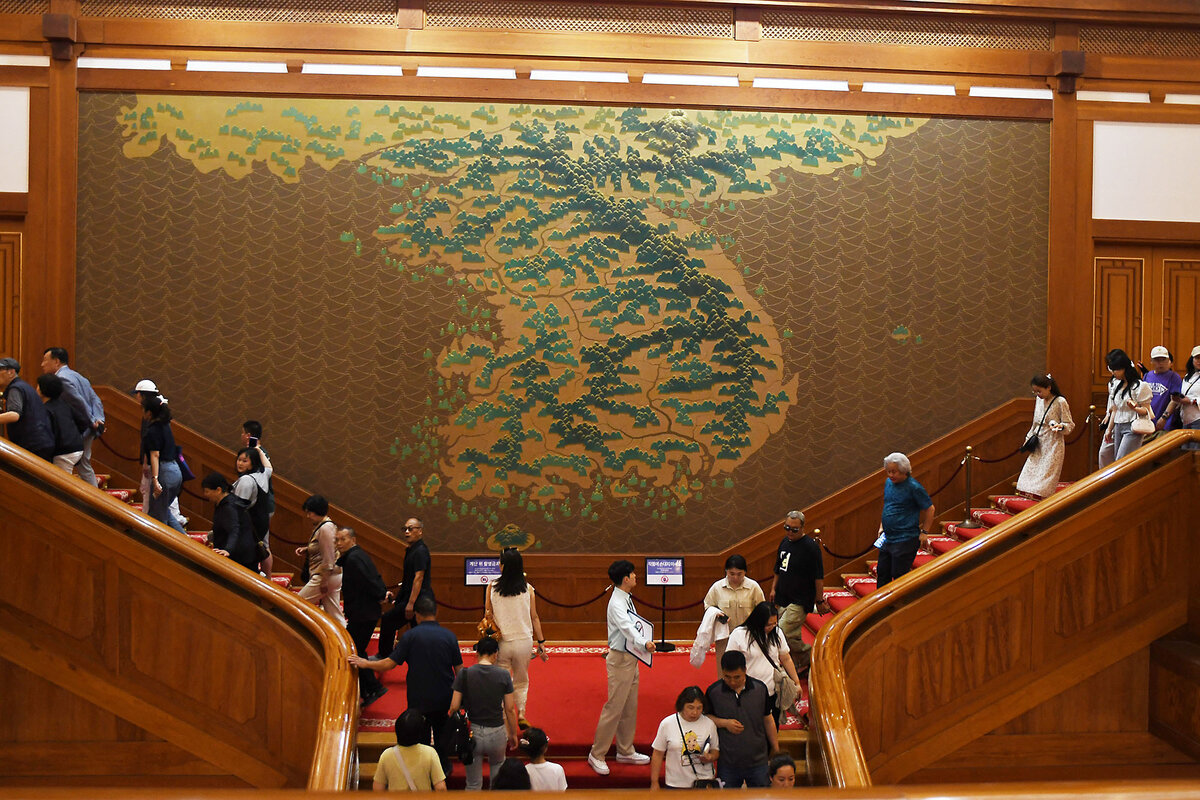South Koreans rush for one last look inside Seoul’s storied Blue House
Loading...
| Seoul, South Korea
“Hurry up, hurry up,” Chae Young-Hee tells her daughter, as they rush from their home in Busan, in southern South Korea, to catch a train for Seoul. “This is our last chance!”
Hours later, the retired Korean language professor is standing below the sweeping eaves of Seoul’s iconic, cyan-tiled Blue House, or Cheong Wa Dae, peeking through a tall glass window and admiring the long-time presidential dining room’s glittering chandeliers.
Millions of South Koreans have visited this 62-acre compound since 2022, when then-President Yoon Suk Yeol broke with a 74-year tradition and turned the presidential office and residence into a public park and museum.
Why We Wrote This
For years, South Korea’s version of the White House has effectively been a public museum – but not anymore. The new president’s return has thousands of tourists flocking to catch a final glimpse inside the Blue House, offering an opportunity to explore what these kinds of buildings mean to a nation.
But now, the unprecedented, three-year public opening of the Blue House is about to end. President Lee Jae-myung – who was elected in June after Mr. Yoon was removed from office for his short-lived imposition of martial law – plans to return to the Blue House. Tours will be curtailed in mid-July and stopped altogether Aug. 1 to prepare for Mr. Lee, who was sworn in immediately following his election.
As tourists seize their last opportunities to enjoy the beauty of the hillside compound overlooking Seoul, some South Koreans are debating the proper use of the Blue House and similar palatial offices.
Around the world, many residences of heads of state, from Japan’s Imperial Palace to the White House to India’s Rashtrapati Bhavan, are at least partially open to the public. In some cases, political turmoil has led presidential residences to be opened to the public abruptly, like when the Philippines’ Malacañang Palace was opened in 1986 after peaceful, mass protests led then-President Ferdinand Marcos to flee. Yet public access is also complicated by the need for security, privacy, and the conduct of official business and ceremonies.
Monument to South Korea’s complicated history
Built behind an ancient palace on the site of dynastic gardens, the Blue House compound has always been highly sequestered. It served as the office of each president from 1948 to 2022.
Mr. Yoon’s team argued the Blue House had become a “royal palace” – a symbol of imperial power shrouded in tight security – and should be handed over to the people. Shunning the Blue House, Mr. Yoon set up his office instead in a defense ministry complex in Seoul’s Yongsan District.
Indeed, symbols of the country’s rule by emperors and strongmen abound, providing part of the tourist appeal. Visitors pose in the gardens wearing flowing Korean hanbok folk costumes, and soak in the grandeur long reserved for elites.
The hipped and gabled roof of the main building resembles Korean palaces. Inside, large columns, red-carpeted staircases, and antique chandeliers dangling from high ceilings evoke a royal setting. A gold phoenix seal adorns the wall over the president’s desk – drawing a steady stream of people taking selfies.
Visitors also pause to study a wall of presidential portraits that serve as a striking reminder of South Korea’s recent authoritarian past – including figures like Chun Doo-hwan, a 1980s military dictator later jailed for abusing his power and violently suppressing protests.
Extracting the president from the Blue House was a healthy move – not just to escape such imperial trappings, but also because the location is inauspicious, argue Korean scholars of feng shui.
Returning to the Blue House – despite bad feng shui
Feng shui – which literally means “wind and water,” or pungsu in Korean – is an ancient art of arranging buildings to be harmonious with the environment.
Jee Jong-hag, an expert at The Korean Society of Feng Shui and Geomancy, says the Blue House’s bad feng shui helps explain why nine of South Korea’s 14 presidents have either been jailed, impeached, overthrown, exiled, or met with violent ends. One longtime leader, Park Chung-hee, was assassinated in 1979 near the Blue House.
“The land is everything – the land never lies and never forgives,” he says.
Mr. Jee explains that the sunken area near the Blue House attracts wind, “the most adverse element,” which translates into difficulty for the person exposed. Then there’s the crooked shape of nearby Bugaksan Mountain. Mr. Jee sees the mountain as a mother figure looking away from the Blue House, as if neglecting it. “That’s why all our presidents had a hard time,” he says.
Still, other experts and visitors support the president’s upcoming return to the Blue House. Without its official purpose, the Blue House risks becoming just another tourist attraction, they say. Moreover, the hillside location of the Blue House offers a unique level of protection for government officials.
“There are many mountains and good security here for the president,” says Kim Cheol-ho, a cinematographer, as he stops to photograph giant trees that are among tens of thousands growing in the wooded compound.
Recent polls indicate that nearly half of South Koreans favor Mr. Lee’s decision to return to the Blue House. Dr. Chae, the retired Korean professor, agrees.
“Of course it’s beautiful here and we are glad it’s been open. The people love this place,” says Dr. Chae. But at the same time, “It’s a symbol of Korean history,” she adds. “Many presidents lived here and that tradition should be continued.”
Kyong Chong supported reporting for this story.








